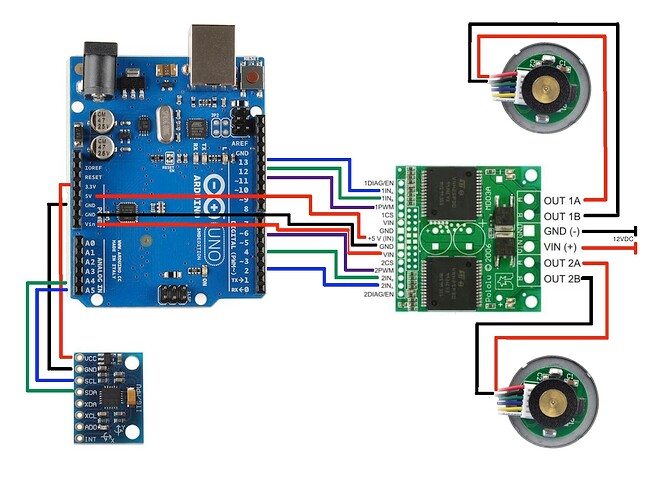My 13 year old son is trying to build a self balancing robot using two 29:1 Metal Gearmotor 37Dx52L mm with 64 CPR Encoder, one Dual VNH2SP30 Motor Driver Carrier MD03A, an Arduino UNO, and a GY521. I’d like to make sure he wires this thing correctly so he doesn’t hurt himself or fry some nice hardware. I’ve looked at the schematics, but I only know enough to be dangerous. The coding isn’t the issue. I just want to make sure it is all connected correctly. Help would be greatly appreciated! Thanks
Hello.
That sounds like an ambitious project, especially for a 13-year-old! If you post a schematic of your proposed connections, I would be happy to look it over. By the way, did you consider our dual VNH5019 motor driver shield? Since it plugs directly into the Arduino, it really simplifies the connections.
- Ben
Hello Ben,
I agree it was a little over ambitious. That’s why I’m here ![]()
I’ll attach the pinning. Any input is appreciated. I didn’t look at the VNH5019 because I didn’t choose the components, but since it was Pololu I knew it had to be good ![]()
Thanks
At first glance, those connections look fine to me, assuming the 3.3V sensor board you are using has 5V-tolerant pins. You might need to consider putting level-shifters between your Arduino’s I2C pins and the sensor board.
The VNH2SP30 is very similar to the VNH5019, so you might consider duplicating the connections that our VNH5019 shield makes. You can find out more about those in its user’s guide. With those connections, you should be able to just use our VNH5019 shield library to control your VNH2SP30 driver.
If you run into any trouble, please let me know.
- Ben
I guess I missed something, because I just blew one of the capacitors on the VNH2SP30. 
Oh no! Are you talking about the big electrolytic capacitors that you have to solder in yourself? The easiest way to destroy one of those is to connect power backwards. Is it possible you did that or accidentally installed one backwards?
The good news is that the board has reverse voltage protection, so it is probably just the capacitor that is damaged (those caps are the only parts outside the reverse protection). Can you remove the damaged cap and see if the board works without any motors connected? You can just use the motor indicator LEDs for feedback.
- Ben

